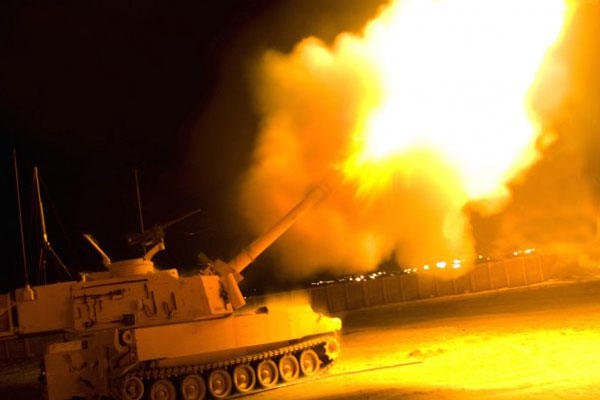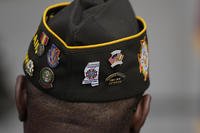WASHINGTON -- Topping the list of things the Army wants in its $127 billion Fiscal Year 2016 budget request are 12 critical programs that support mission command, joint combined arms maneuver, and broad joint mission support.
Experts within the Army's G-8, responsible for matching programs with limited resources, were quick to point out that the list of items are in no prioritized order, but that they are all high-dollar programs that are critical to the Army mission.
"It shows Congress where we are spending taxpayer dollars. These programs also provide critical capability to Soldiers," said. Col. Brian Halloran, Army G-8 force development division chief for plans, strategy and policy. "How we chose these 12 specific programs from the more than 200 we have going on is three-fold: these are programs with high-dollar investment by the nation; and they also provide very increased capability to the Soldier and they nest within our broad priorities within the strategy as well."
Supporting mission command initiatives is the Nett Warrior system, which is an Android-based cell phone that has been modified to work with Army communications systems to bring critical operational information to the dismounted leaders of platoons, squads, and teams.
The 2016 budget request includes funding to allow the system to be fielded at the tactical level in three brigade combat teams, said Col. Richard Price, Army G-8 force development division chief for mission command.
"That will go down to the team-leader level, to allow them to use commercial, off-the-shelf equipment to display maps and position data," Price said. "It's an Android phone, where we take off the proprietary software, and we put Army software on it, so we can display Army applications, which give you maps and location data."
Price said for Nett Warrior, the Army has reached a level of robustness and readiness with the hardware to field the system, but added that the software component will continue to improve for a long time.
"As we continue to develop apps, it will give you the capability to display information from the Advanced Field Artillery Tactical Data System, unit data, war plans, operations orders and other things on the screen," he said.
Price said the Nett Warrior supports the Army, and is critical in that it provides the dismounted leader - the Army's most critical "resource" - with the information he or she needs to do their job.
"It allows you to share information down to the lowest tactical level, with the team leaders on the ground, and allows you to understand from a location standpoint where those team leaders are located," Price said.
Price also said the Army wants to field to three brigade combat teams, or BCTs, the communications equipment included in the family of networked tactical radios, including the rifleman radio at the squad and platoon level, the "handheld, manpack and small-form fit" radios at the platoon and company level, and the maneuver radio that connects everything to Army command elements.
Also making the list in support of mission command capabilities is the Warfighter Information Network - Tactical system, the Joint Battle Command - Platform, and the Distributed Common Ground System - Army.
The Joint Light Tactical Vehicle, or JLTV, which is a joint program between the Army and the Marine Corps, makes the list as a contributor to the joint combined arms maneuver mission. Right now there are three commercial contractors competing to win the JLTV program contract. Those contractors include Lockheed Martin, Oshkosh Defense and AM General.
Col. Michel M. Russell Sr., Army G-8 FD division chief for focused logistics, said the Army expects to exit the current engineering and manufacturing development stage of the JLTV competition, and down-select from three contractors to one as part of an acquisition decision in the fourth quarter of FY 2015. That one winning contractor will be awarded the low-rate initial production contract for the JLTV.
The Army plans to eventually purchase 49,099 JLTVs, while the Marine Corps plans to eventually buy 5,500 of the vehicles. For the Army, initial operating capability on the JLTV is expected in the fourth quarter FY 2018.
Russell said in light tactical vehicles, the Army looks for three primary components: payload, performance and protection. Those three characteristics together, he said, are referred to as "the iron triangle."
"What JLTV does is it meets the capability gap that allows us to bring all three of those back into balance," Russell said. "We gain all that back, and it's deployable in all the different environments."
Also included in the 12 critical programs for the Army is the Maneuver Support Vessel - Light, or MSV-L, a watercraft that is intended to replace the existing Vietnam-era Landing Craft Mechanized 8. The MSV-L supports the Joint Combined Arms Maneuver and the Army Operating Concept, Russell said.
"It's a new start program, and is critical because it is the lynchpin to the Army's watercraft strategy," Russell said.
He said the MSV-L will allow commanders to maneuver supplies, sustainment and systems in and around their waterscape. The watercraft can carry a tank, a JLTV, a Stryker, troops, or supplies.
"This is a brand new program and will have to proceed through the acquisition milestone agenda, in terms of requests for production and getting bids back from original equipment manufacturers, doing testing, RDT&E [research, development, test and evaluation], procurement, the whole nine yards," Russell said.
Despite this meticulous process the Army must go through to provide Soldiers the best equipment available, Russell said he expects the MSV-L can be fielded in as little as six years. The system is not a "developmental" program, in that it will not be designed from scratch. Instead, he said, it is very likely the MSV-L will be based on an existing "commercial off-the-shelf" watercraft that will be "ruggedized and made to fit the Army's mission profile."
"With the current emphasis on this particular vessel, and how it anchors to the Army Operating Concept for watercraft operations for combatant commanders, there is a lot of emphasis on getting this program moving," Russell said.
Also supporting joint combined arms maneuver within the 12 critical programs is the AH-64 Apache helicopter. The Army resourcing for the Apache is mostly to convert existing D-model aircraft into E model aircraft.
James St. Amour, a civilian working in Army G-8 force development as a staff synchronization officer for AH-64, said the move is, "a huge underpinning of our modernization effort." The modernization effort is possible due to the cost savings and avoidance that the Army's Aviation Restructure Initiative provides.
Conversion from D to E models involves "depopulating the airframe and rebuilding the helicopter from the ground up. The aircraft gets a totally new fuselage, a new rotor system and other component parts. It's like a new aircraft coming off the line," St. Amour said. "The E model resets the airframe to zero hours."
Right now there are fewer than 100 E model Apaches in the Army. But the goal is to have all 690 Apaches in the Army modernized to E models.
With the Apache E model, AH-64E, the Army will pair the combat helicopter with the Shadow unmanned aerial vehicle to fill the armed reconnaissance role filled by the OH-58 Kiowa helicopter. The Kiowa is being divested from the Army, and St. Amour said all will be gone from the fleet by 2018.
There are 104 Shadow "systems" in the Army, each of which includes four aircraft, two ground control stations, antennas and data terminals. There are 416 Shadow aircraft in the Army, and as part of paring those aircraft with the Apache E model, the Army plans to upgrade those Shadows to V2 Shadow models. Right now, none have made the transition, but they will eventually have longer wings, better endurance, a different engine, and a different datalink, St. Amour said.
As part of the Aviation Restructure Initiative, the Army plans to have all combat aviation brigades converted to the new structure by 2019. Once fully fielded, the AH-64E provides Army Aviation with a much more lethal and capable force.
Rounding out the Army's Critical Programs that support joint combined arms maneuver are the Armored Multi-Purpose Vehicle, the Patriot Missile, the Paladin Integrated Management program, and the UH-60 Black Hawk. Both the Black Hawk and the MSV-L also add to the Army's broad joint mission support capabilities.
Don't Miss a Single Military.com Story
To read the full article and get exclusive benefits, sign up today.
It’s FREE
Why am I seeing this? Visit our FAQs





























